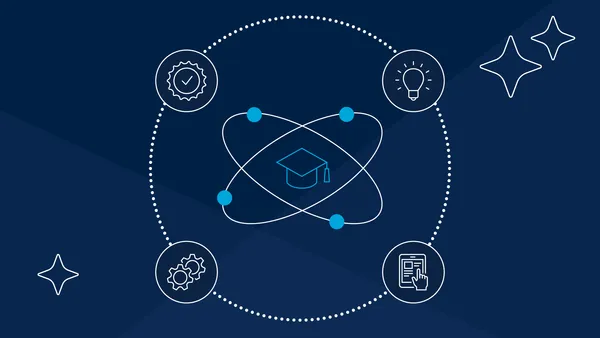With college enrollment mostly flat and the number of adult learners taking online classes expected to increase, it doesn't take a business major to determine that more colleges and universities will be targeting this largely untapped student segment.
Several have already made moves to that effect, including the University of Massachusetts System, which last month announced plans for a national online college focused on these so-called "nontraditional" students.
But traditionally campus-based institutions can find themselves outpaced as they try to match offerings from online-only schools, especially when it comes to critical services that can help attract and retain students, such as financial aid and academic advising. The act of retrofitting these typically on-campus services to meet the needs of a new subset of students can be awkward, especially compared to the streamlined offerings of online-only institutions.
Colleges leaders looking to distill the problem should consider the hours many of these students keep. Take Sunday evening, which for most colleges is a time when many of their support services are unavailable, waiting to reopen on Monday morning. For a student juggling a job and a family, however, Sunday evening can be a prime time to do schoolwork.
If that student encounters a problem — anything from a question about their financial aid status to confusion over how to post a reply on a class message board — the opportunity to help them could be lost, and it could be days before the student can clear that hurdle.
"With the growth in popularity of online education, there is a great deal of competition for these students," said Sue Ohrablo, a college advising consultant. "Establishing a point of difference in support will help attract new students. A popular phrase that's heard when discussing these strategies is 'concierge-level service.'"
Incorporating technology
While small and large institutions alike can struggle to set up supports for online students, online-only schools are zooming ahead when it comes to technological achievements.
Artificial intelligence (AI) "is changing the game," said Erika Orris, chief enrollment and marketing officer at the University of Maryland University College (UMUC). Founded in 1947 to help educate veterans, it now serves more than 80,000 students around the world as one of 12 degree-granting institutions in the University System of Maryland. UMUC started offering online classes in the mid-'90s. To reflect its transition to a fully online institution, UMUC plans to change its name to the University of Maryland Global Campus.
For its part, the college already uses AI to run mock interviews for students and will roll out an AI-driven advising model within the next couple of months. "We're a little late launching ours," Orris added.
UMUC has also streamlined its registration model to allow for two-click sign-up. And the online college promises students a 48-hour turnaround on responses from its writing center and runs a call center that operates 24/7.
"Students don't have a lot of time for administrative tasks," Orris said. "We need to get all of those things out of the way so they can focus on schoolwork."
Shifting online
At Winona State University, which serves fewer than 8,000 undergraduates in Minnesota, progress has come slower. Darcie Anderson Mueller and Amy Meyer, both academic advisers at the school's Warrior Success Center, used a $6,000 grant from the university to create an online component to Winona's advising and career counseling services office.
While Winona is ahead of most campus-based schools today, the pair admit it was hard to push the entire student workflow online. Often, there would be a form that needed a signature, requiring the student to come to campus. Now, the Winona administration not only accepts online forms, but it also offers a web-based counseling service started by Anderson Mueller and Meyer for off-campus students to get face time with staff. As the pair have attended regional and national advising conferences, "We haven't seen other schools that have been this comprehensive," Meyer said.
There's also an unexpected benefit at Winona. While the college has revamped the system to better serve online students, the pair find many campus-based learners use the services during extended hours. In fact, the heaviest usage times are during winter break.
"Establishing a point of difference in support will help attract new students. A popular phrase that's heard when discussing these strategies is 'concierge-level service.'"

Sue Ohrablo
College advising consultant
Winona's example of making some progress before finding gaps in its system isn't novel. To combat these oversights, Victoria Brown, assistant provost for eLearning at Florida Atlantic University, helped create a Quality Scorecard for Online Student Support.
The checklist, introduced last fall by the Online Learning Consortium, covers 11 service areas within an institution. They range from expected offerings such as admissions and financial aid to graduate student support and services for those with disabilities. The scorecard is meant to help distance learning administrators ensure an institution is covering all its bases for online students, she said.
While combing through various institutions' online offerings, Brown discovered some common areas of weakness. Many institutions still require graduate students to do research or apply for grants on campus. Most colleges realize they need to extend services beyond normal work hours, but many are struggling to find the right mix of support, she said. In some cases, a phone call can fix a problem, but in other areas, students crave the stronger connection that a video chat can help build.
"Online students may feel isolated and disconnected from the institution," Ohrablo said. But they may also be seeking information during their commutes or on a lunch hour, making features like web conferencing impractical. "It is important to provide synchronous and asynchronous opportunities for online students to obtain the assistance they need," she said.
Minding the competition
Primarily campus-based colleges that want to enhance their support for remote students should pay attention to institutions that offer online education at scale.
Western Governors University uses a rolling admission system to welcome 6,000 new students each month, said Bob Collins, the institution's vice president of financial aid. The university has 115,000 full-time students, who are enrolled in self-paced competency-based education courses that run on six-month terms that kick off on the first day of each month.
The university also simplified its support services around students' four most common needs, Collins said. Technical assistance is the highest priority for the online-only college and is offered seven days a week with extended hours, though not 24/7. Next in importance is assessment delivery, which addresses students' questions about issues such as taking proctored exams or finding a testing center. That service is also available seven days a week.
"Students don't have a lot of time for administrative tasks. We need to get all of those things out of the way so they can focus on schoolwork."

Erika Orris
Chief enrollment and marketing officer, University of Maryland University College
The third and fourth options, financial aid and student services such as academic counseling, are less vital because the related tasks don't stand in the way of students completing their work, Collins said. These services are offered five and six days a week, respectively.
Collins said the university does not have a target ratio of counselors to students, but it does adhere to a simple rule: 70% of the time a phone call will be answered within 30 seconds, and 92% of the questions or problems are addressed within 24 hours.
While there is little research linking online services offered to student success, there is a growing realization of the vital role they can play, Ohrablo said.
"Institutions are realizing the importance of engaging and supporting online students in order to foster student retention and success," she said. "The attrition rates of online students tend to be higher than their campus-based counterparts, and institutions recognize the importance of closing that gap."





















